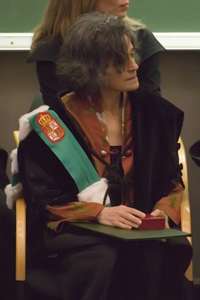Bahiyyih Nakhjavani

Bahiyyih Nakhjavani is an Iranian writer who grew up in Uganda and was educated at Dr. Williams' School, Dolgellau, United Kingdom and the United States. She now lives in France where she teaches.[1] She taught European and American literature in Belgium.
In 2007, Bahiyyih Nakhjavani received the honorary doctorate Doctorats Honoris Causa from the University of Liège.[1] Her books have been translated into many languages.
Novels
Her first novel The Saddlebag - A Fable for Doubters and Seekers was an international bestseller. It describes events set in the Najd plateau along the pilgrim route between Mecca and Medina during one day in 1844-1845, when a mysterious saddlebag passes from hand to hand, and influences the lives of each person who comes across it. Inspired by Chapter VII of The Dawn-Breakers by Nabíl-i-A`zam, where the Bab - the forerunner to Baha'u'llah, the Founder of the Baha'i Faith - has His saddlebag stolen while travelling to Mecca and Medina for pilgrimage. The main characters are the Thief, the Bride, the Chieftain, the Moneychanger, the Slave, the Pilgrim, the Priest, the Dervish and the Corpse.
The novel Paper - The Dreams of A Scribe is an allegory centered on a Scribe who is searching for perfect paper for writing his masterpiece. It is set in Máh-Kú, a bordertown in north-west Persia, between the Summer of 1847 and the Spring of 1848. It contains 19 chapters which are structured symmetrically around five dreams. Other main characters are the Mullah, the Widow, the Warden, his Mother and his Daughter, and the Prisoner.
Her third novel The Woman Who Read Too Much is also set in the middle of the nineteenth century, and centers around Tahirih Qurratu'l-Ayn, a poet and scholar from Qazvin, who shocked the political powers of Qajar Persia and violated religious convention by casting aside her veil. This protagonist is a heroine from early Baha'i/Babi history and was one of the Bab's early followers who were known as the Letters of the Living. This novel is divided into four parts with revolving points of view, of mother, sister, daughter and wife respectively. It traces the capture, incarceration, torture and final execution of the central figure of the mysterious poet while exploring her impact on mayor, minister, mullah and monarch in a world of intrigue and corruption in Qajar Persia. The book has been translated into French, Italian in 2007 and will be out in Korean and Spanish by 2008/9;[2] it was nominated for the 2008 Latifeh Yashater Award, and has been published in English by Stanford University Press in 2015.
Bibliography
- Bahiyyih Nakhjavani (1979). When We Grow Up. Oxford, UK: George Ronald. ISBN 0-85398-086-1.
- Bahiyyih Nakhjavani (1981). Response. Oxford, UK: George Ronald. ISBN 0-85398-107-8.
- Bahiyyih Nakhjavani (1983). Four on an Island. Oxford, UK: George Ronald. ISBN 0-85398-174-4.
- Bahiyyih Nakhjavani (1990). Asking Questions: A Challenge to Fundamentalism. Oxford, UK: George Ronald. ISBN 0-85398-314-3.
- Bahiyyih Nakhjavani (2000). The Saddlebag - A Fable for Doubters and Seekers. London, UK: Bloomsbury Publishing Plc. ISBN 0-8070-8342-9.
- Bahiyyih Nakhjavani (2004). Paper - The Dreams of A Scribe. London, UK: Bloomsbury Publishing Plc. ISBN 0-7475-6921-5.
- Nakhjavani, Bahiyyih (2015). The Woman Who Read Too Much: A Novel. Stanford, CA: Stanford University Press. ISBN 9780804794299.
See also
References
- 1 2 Author Bahiyyih Nakhjavani honored in Belgium
- ↑ French: Actes Sud, Italian: Libreria Rizzoli, Spanish: Alianza Editorial.
External links
- Bloomsbury author information
- Novels and Iranian History: Beyond Diaspora, a public lecture and reading by Bahiyyih Nakhjavani, Ecole Superieure des Arts Decoratifs de Strasbourg, France, April 16, 2008.
- Interview in English/Italian on RAI3, about herself and her writing